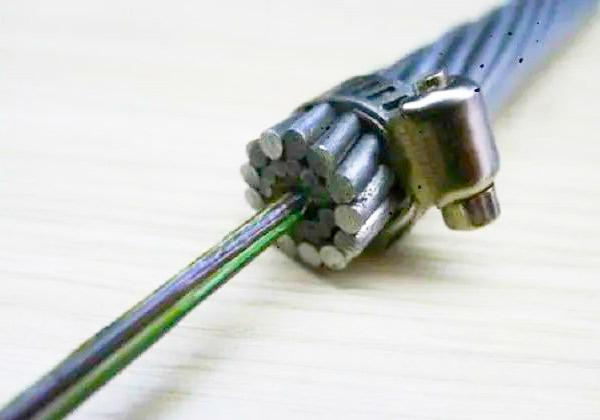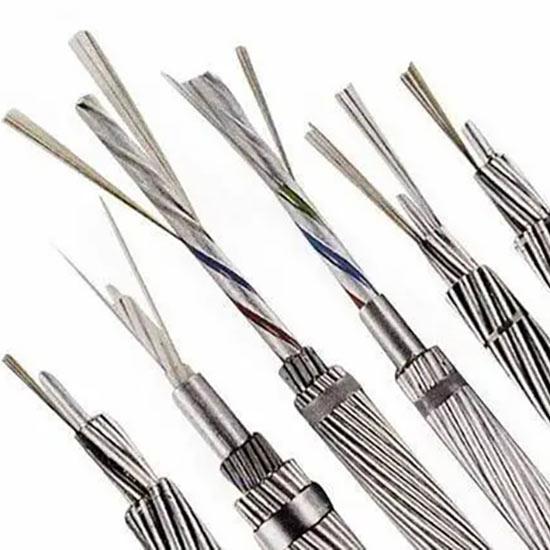Product Model: OPGW-24B1-40
Product structure: It is aluminum tube type, aluminum skeleton type, and (stainless) steel tube type.
Laying method: overhead
Operating temperature: -40℃~ 65℃

Application range
OPGW fiber optic cable is mainly used in 500KV, 220KV, and 110KV voltage level lines, subject to line blackout, security, and other factors, more in the new line applications.
OPGW optical cable performance
- Applicable to all kinds of new overhead power lines and the renovation of existing power lines
- Good structure compactness
- High tensile strength
- Low mutual interference between power grid and communication network due to short circuit current
- Transmission of various control signals for multi-way broadband communication
- Advanced stainless steel tube production technology, the tube is filled with water-blocking compounds, which can effectively protect the fiber
- The remaining length of the fiber and the core stranding pitch ensures that the OPGW optical fiber cable is not under stress when it is under maximum operating tension.
- Similar to the common ground wire specifications, it is very convenient to set up and can directly replace the original ground wire.
OPGW fiber optic cable type
There are three main types of structure: aluminum tube type, aluminum skeleton type, and (stainless) steel tube type.
OPGW fiber optic cable applications:
OPGW power optical cable is mainly used in 500KV, 220KV, and 110KV voltage level lines, subject to line outages, security, and other factors, more in the new line applications.
Applicable characteristics of OPGW
(1) high voltage over 110kv lines, the file distance is large (generally above 250M).
(2) Easy to maintain, easy to solve for line crossing problems, its mechanical characteristics can meet the line large crossing.
(3)The outer layer of OPGW is metal armored, which does not affect high voltage galvanic corrosion and degradation.
(4)OPGW must be blacked out during construction, and the loss of power outage is large, so OPGW should be used in new high-voltage lines above 110kv.
(5)Among the performance indexes of OPGW, the higher the short-circuit current is, the more it needs to be armored with a good conductor, then the tensile strength is reduced accordingly, and with a certain tensile strength, the only way to increase the short-circuit current capacity is to increase the metal cross-sectional area.

OPGW fiber optic cable installation design
The installation design of OPGW should take into account the stress of the conductor, the arc sag, and the insulation gap, as well as its load, which should not exceed the use range allowed by the existing tower and foundation. Therefore, the characteristic curve of OPGW should be calculated according to the main technical parameters of the selected OPGW, and the layout, shape, and installation diagrams of junction boxes, various types of fixtures, and accessories should be designed according to the actual project.
- In The initial elongation of the processing of the initial elongation of the Optical Power Ground Wire, the cooling method can be used, that is, to review the aluminum steel ratio of the OPGW, concerning the cooling value of similar conductors or ground wire processing its initial elongation.
- anti-vibration measures design OPGW supporting the use of the fixture, withstanding wire clamps for pre-stranded wire type, pendant wire clamps with pre-stranded wire, rubber liner, these two types of fixtures already have a certain anti-vibration capacity. To further strengthen the ability to prevent vibration, one can consider the installation of an anti-vibration hammer, generally calculated by file distance: file distance ≤ 300M, the installation of an anti-vibration hammer; file distance > 300M, the installation of two anti-vibration hammer.
- The construction and erection of OPGW are different from ordinary steel stranded wire, so attention should be paid to prevent permanent damage to avoid affecting the performance of optical fiber in the future, and consideration should be given to twisting of OPGW, slight bending, local radial pressure outside the wire clamp and pollution of optical fiber.
Therefore, the following effective measures should be taken to address them during the construction phase.
(1) Prevent OPGW twisting in the walking plate and tight wire clamp with a balanced hammer, or anti-twist device; use special double-slotted pulleys; use a double-stranded tension anti-wire machine.
(2) Prevent and reduce the micro-bending and stress of OPGW do not allow sharp angles to appear (control the minimum bending radius of 500mm);
The diameter of the OPGW cable tray should be not less than 1500mm. The diameter of the pulley should be more than 25 times the diameter of OPGW, generally not less than 500mm. The inner side of the pulley should have a nylon or rubber liner to prevent rubbing the surface of OPGW. Suitable traction line and wire release gold.
Specify the maximum disk length of OPGW as 6000M to prevent the number of times over the pulley.
Limit the continuous line release to ≤30°, and the OPGW should be in the shape of “C” after the corner in a release tension section.
(3)Tension control: use a hydraulic tension release machine and traction machine with a tension release device; limit the release speed to ≤ 0.5m/sec.
(4) Prevent fiber contamination. In the construction and erection of OPGW, attention should be paid to encapsulating the ends.
In addition, before the Optical Power Ground Wire for Transmission use arrives at the site, before the erection, after the erection and after the completion of the whole construction, the acceptance test of the optical fiber decay of OPGW should be carried out at the site in time.
